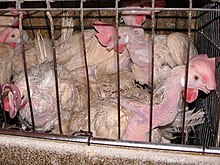Права животиња


| Права |
|---|
 |
| Теоретска одређења |
| Људска права |
| Категорије права по ималацу |
| Друге групе права |
Права животиња су филозофија према којој многе или све живе животиње имају моралну вредност независно од њихове корисности за људе, као и да се њиховим најосновнијим интересима — као што је избегавање патње — треба приуштити исто разматрање као и слични интереси људских бића.[1] Уопштено говорећи, а посебно у популарном дискурсу, термин „права животиња” се често користи као синоним за „заштиту животиња” или „ослобођење животиња”. Уже речено, „права животиња” се односе на идеју да многе животиње имају основна права да се према њима поступа с поштовањем као према појединцима — право на живот и слободу од мучења која не могу бити превладана разматрањем укупног благостања.[2]
Многи заговорници права животиња противе се додељивању моралне вредности и фундаменталне заштите само на основу припадности врсти.[3] Они сматрају ову идеју, познату као специзам, предрасудом једнако ирационалном као и свака друга.[4] Тврде да животиње не треба посматрати као власништво или користити као храну, одећу, забаву или рад само зато што нису људи.[5] Више културних традиција широм света као што су џаинизам, таоизам, хиндуизам, будизам, шинтоизам и анимизам такође подржавају облике животињских права.
Види још[уреди | уреди извор]
Референце[уреди | уреди извор]
- ^ DeGrazia (2002), ch. 2; Taylor (2009), ch. 1.
- ^ Taylor (2009), ch. 3.
- ^ Compare for example similar usage of the term in 1938: The American Biology Teacher. 53. National Association of Biology Teachers. 1938. стр. 211. Приступљено 16. 4. 2021. „The foundation from which these behaviors spring is the ideology known as speciesism. Speciesism is deeply rooted in the widely-held belief that the human species is entitled to certain rights and privileges.”
- ^ Horta (2010).
- ^ That a central goal of animal rights is to eliminate the property status of animals, see Sunstein (2004), p. 11ff.
- For speciesism and fundamental protections, see Waldau (2011).
- For food, clothing, research subjects or entertainment, see Francione (1995), p. 17.
Литература[уреди | уреди извор]
- Lubinski, Joseph (2002). "Overview Summary of Animal Rights", The Animal Legal and Historical Center at Michigan State University College of Law.
- "Great Apes and the Law", The Animal Legal and Historical Center at Michigan State University College of Law.
- Bekoff, Marc (ed.) (2009). The Encyclopedia of Animal Rights and Animal Welfare. Greenwood.
- Best, Steven and Nocella II, Anthony J. (eds). (2004). Terrorists or Freedom Fighters? Reflections on the Liberation of Animals. Lantern Books
- Chapouthier, Georges and Nouët, Jean-Claude (eds.) (1998). The Universal Declaration of Animal Rights. Ligue Française des Droits de l'Animal.
- Dawkins, Richard (1993). Gaps in the mind, in Cavalieri, Paola and Singer, Peter (eds.). The Great Ape Project. St. Martin's Griffin.
- Dombrowski, Daniel (1997). Babies and Beasts: The Argument from Marginal Cases. University of Illinois Press.
- Favre, David S. (2018). Respecting Animals: A Balanced Approach to Our Relationship with Pets, Food, and Wildlife. Prometheus. ISBN 978-1633884250.
- Foltz, Richard (2006). Animals in Islamic Tradition and Muslim Cultures. Oneworld Publications.
- Franklin, Julian H. (2005). Animal Rights and Moral Philosophy. University of Columbia Press.
- Gruen, Lori (2003). "The Moral Status of Animals", Stanford Encyclopedia of Philosophy, July 1, 2003.
- Gruen, Lori (2011). Ethics and Animals. Cambridge University Press.
- Hall, Lee (2006). Capers in the Churchyard: Animal Rights Advocacy in the Age of Terror. Nectar Bat Press.
- Linzey, Andrew and Clarke, Paul A. B.(eds.) (1990). Animal Rights: A Historic Anthology. Columbia University Press.
- Mann, Keith (2007). From Dusk 'til Dawn: An Insider's View of the Growth of the Animal Liberation Movement. Puppy Pincher Press.
- McArthur, Jo-Anne and Wilson, Keith (eds). (2020). Hidden: Animals in the Anthropocene. Lantern Publishing & Media.
- Neumann, Jean-Marc (2012). "The Universal Declaration of Animal Rights or the Creation of a New Equilibrium between Species". Animal Law Review volume 19–1.
- Nibert, David (2002). Animal Rights, Human Rights: Entanglements of Oppression and Liberation. Rowman and Litterfield.
- Nibert, David, ур. (2017). Animal Oppression and Capitalism. Praeger Publishing. ISBN 978-1440850738.
- Patterson, Charles (2002). Eternal Treblinka: Our Treatment of Animals and the Holocaust. Lantern.
- Rachels, James (1990). Created from Animals: The Moral Implications of Darwinism. Oxford University Press.
- Regan, Tom and Singer, Peter (eds.) (1976). Animal Rights and Human Obligations. Prentice-Hall.
- Spiegel, Marjorie (1996). The Dreaded Comparison: Human and Animal Slavery. Mirror Books.
- Sztybel, David (2006). "Can the Treatment of Animals Be Compared to the Holocaust?" Ethics and the Environment 11 (Spring): 97–132.
- Tobias, Michael (2000). Life Force: The World of Jainism. Asian Humanities Press.
- Wilson, Scott (2010). "Animals and Ethics" Internet Encyclopedia of Philosophy.
- Kymlicka, W., Donaldson, S. (2011) Zoopolis. A Political Theory of Animal Rights. Oxford University Press.
